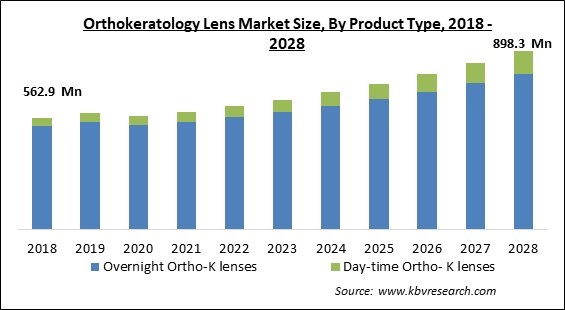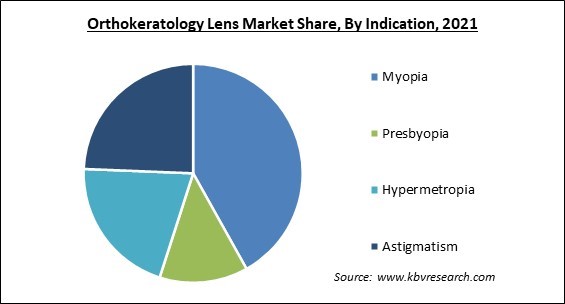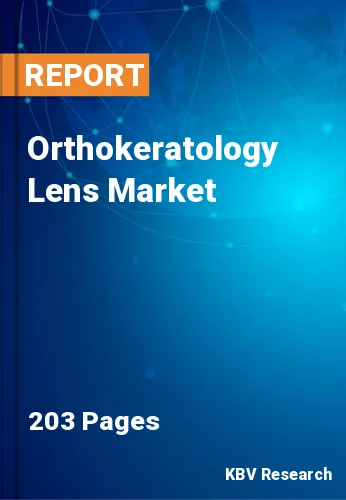The Global Orthokeratology Lens Market size is expected to reach $898.3 Million by 2028, rising at a market growth of 6.4% CAGR during the forecast period.
Orthokeratology is a method of refractive error correction that uses bespoke gas permeable contact lenses to temporarily alter the corneal curvature. Orthokeratology, also known as ortho-k, corneal refractive therapy (CRT), and nighttime vision correction therapy, is a non-surgical procedure that corrects refractive problems by altering the cornea's curvature to enhance object visibility. To enable quicker as well as more effective corneal reshaping, modern ortho-K technology reverses geometry designs and uses breathable stiff lens material. This technique, which involves temporary medication, is used to treat myopia, hypermetropia, and other vision-related issues. Myopia, hypermetropia, astigmatism, & presbyopia occurrences are predicted to rise, which will help the industry.

Wearing lenses that reduce eye sight issue progression and correct eye sight may sound like a fantasy, but it's actually a reality. Orthokeratology lenses are not exactly a novel concept. However, these lenses have just recently begun to make significant strides. Due to development of advanced and precise technology, the field of technology is currently really advancing. These tools facilitate and expedite the production of 3D models of the eye's surface. The enhanced polymer substance that makes hard contact lenses more oxygen permeable is another driving force behind the new technology.
But since the pandemic began, there has been a significant change, and many more people are now more likely to have refractive defects. It is anticipated that the move toward online education and the widespread adoption of work-from-home policies by businesses would lead to an increase in peoples' overall screen time and an increase in refractive errors. Consequently, it is possible to predict that during the upcoming years, the market. The main driver fueling the market expansion is key manufacturers' increased efforts to introduce new products and obtain regulatory approvals. Additionally, the market is growing significantly because of the increasing burden of patients with refractive defects.
The decrease in patient visits to hospitals & clinics brought about by the COVID-19 pandemic had a marginally negative effect. The outbreak of pandemics that swept the world significantly altered how the health care industry is managed. Nobody has been in a decent physical, mental, or emotional state during the pandemic. The government had declared rigorous internment as the coronavirus was about to break out, and individuals were confined to their houses, which increased screen time. People's eyesight was impacted by excessive exposure to laptops & personal computers. Despite the difficulties that several industries faced during the pandemic, the worldwide orthokeratology market expanded significantly.
Myopia & high myopia are becoming more and more commonplace on a massive level. Myopia is a significant public health issue, and excessive myopia is the second-leading factor in the visual impairment globe. In East Asia, the prevalence of myopia is among a large number of students and affected around half of the urban population. Additionally, because myopia's visual difficulties begin earlier than other causes of blindness like cataracts, its effects on quality of life are also seen earlier. The cost of eye illnesses in various developed regions is estimated to be in the millions. Myopia prevention, as well as control techniques, are therefore highly sought after on a worldwide scale.

Digital gadgets such as laptops, tablets, smartphones, and e-readers have become an essential part of everyday life. Most occupations necessitate working on computers for extended periods of time. In addition, the need of staying connected has increased with the rise of social networking sites. A worrying trend has been seen where people turn on their cell phones as soon as they get up and continue their trust with digital screens until they go to bed. In addition, the rising use of digital screens has given rise to a disorder called Computer Vision Syndrome (CVS), which harms the eyes and causes issues with vision.
There are various alternatives available in the market like multifocal contact lenses and atropine eye drops. MiSight lenses are the first type of FDA-approved contact lenses for preventing childhood myopia progression. Children as young as 8 years old may be prescribed these soft, disposable lenses. At night, the lenses are removed after being worn during the day. These lenses include concentric rings that refocus light so that it strikes the retina in a different way, deceiving the eye into not enlarging too much. Although the lenses can correct astigmatism.
Based on product type, the orthokeratology lens market is segmented into overnight ortho-K lenses and day-time ortho- K lenses. In 2021, overnight ortho-K lenses dominated the orthokeratology lens market with the highest revenue share. This is attributed to the easy availability of overnight ortho-K lenses. In addition, ortho-k lenses are customized contact lenses. The user can wake up with clear vision without the need for glasses or contacts the next day. Ortho K lens softly reshapes the eye overnight. All these factors are supporting market growth in this segment. The main advantage of these lenses is that they are needed to be worn only at night.
On the basis of indication, the orthokeratology lens market is fragmented into myopia, presbyopia, hypermetropia and astigmatism. In 2021, the astigmatism segment covered a significant revenue share in the orthokeratology market. The vision may become distorted or fuzzy if someone has astigmatism, a common condition of the eyes. It occurs when the cornea the transparent outer layer of the eye or lens the inner portion of the eye that aids in eye focus have an abnormal shape. The demand for ortho-k lenses is rising in this segment as spherical ortho-k lenses are available which have the ability to reshape the anterior surface of the cornea.
By distribution channel, the orthokeratology lens market is classified into hospitals, optometry clinics, ophthalmology clinics and others. In 2021, the North America region witnessed the largest revenue share in the orthokeratology lens market. The increase in the prevalence and incidence of vision errors, as well as the number of qualified specialists, are indicators of the market expansion in this region. Additionally, the market in this region is being driven by the rising awareness of the use of ortho-k lenses, successful compensation policies, and market penetration by key competitors in the region.
| Report Attribute | Details |
|---|---|
| Market size value in 2021 | USD 590.7 Million |
| Market size forecast in 2028 | USD 898.3 Million |
| Base Year | 2021 |
| Historical Period | 2018 to 2020 |
| Forecast Period | 2022 to 2028 |
| Revenue Growth Rate | CAGR of 6.4% from 2022 to 2028 |
| Number of Pages | 203 |
| Number of Tables | 359 |
| Report coverage | Market Trends, Revenue Estimation and Forecast, Segmentation Analysis, Regional and Country Breakdown, Companies Strategic Developments, Company Profiling |
| Segments covered | Product Type, Distribution Channel, Indication, Region |
| Country scope | US, Canada, Mexico, Germany, UK, France, Russia, Spain, Italy, China, Japan, India, South Korea, Singapore, Malaysia, Brazil, Argentina, UAE, Saudi Arabia, South Africa, Nigeria |
| Growth Drivers |
|
| Restraints |
|
Region-wise, the orthokeratology lens market is analyzed across North America, Europe, Asia Pacific and LAMEA. In 2021, the North America region witnessed the largest revenue share in the orthokeratology lens market. The increase in the prevalence and incidence of vision errors, as well as the number of qualified specialists, are indicators of the market expansion in this region. Additionally, the market in this region is being driven by the rising awareness of the use of ortho-k lenses, successful compensation policies, and market penetration by key competitors in the region.
Free Valuable Insights: Global Orthokeratology Lens Market size to reach USD 898.3 Million by 2028
The market research report covers the analysis of key stake holders of the market. Key companies profiled in the report include Johnson & Johnson (Johnson & Johnson Vision Care, Inc.), Bausch Health Companies, Inc., The Cooper Companies, Inc., Euclid Systems Corporation, Alpha Corporation, Inc. (Menicon Co., Ltd.), Brighten Optix Corporation, TruForm Optics, Inc., Art Optical Contact Lens, Inc., and MiracLens, LLC.
By Product Type
By Indication
By Distribution Channel
By Geography
The global Orthokeratology Lens Market size is expected to reach $898.3 Million by 2028.
Increase In Cases Of Myopia & High Myopia are driving the market in coming years, however, Availability Of Various Alternatives In The Market restraints the growth of the market.
Johnson & Johnson (Johnson & Johnson Vision Care, Inc.), Bausch Health Companies, Inc., The Cooper Companies, Inc., Euclid Systems Corporation, Alpha Corporation, Inc. (Menicon Co., Ltd.), Brighten Optix Corporation, TruForm Optics, Inc., Art Optical Contact Lens, Inc., and MiracLens, LLC.
The expected CAGR of the Orthokeratology Lens Market is 6.4% from 2022 to 2028.
The Myopia segment is leading the Global Orthokeratology Lens Market by Indication in 2021, thereby, achieving a market value of $361.1 Million by 2028.
The North America market dominated the Global Orthokeratology Lens Market by Region in 2021, and would continue to be a dominant market till 2028; thereby, achieving a market value of $318 Million by 2028.
Our team of dedicated experts can provide you with attractive expansion opportunities for your business.

